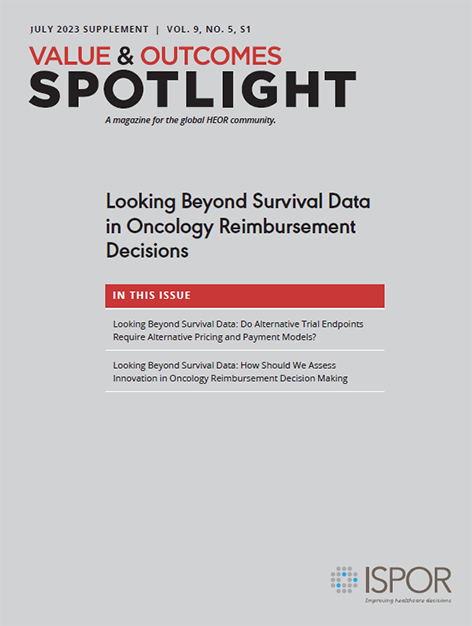Commentary
Looking Beyond Survival Data: Do Alternative Trial Endpoints Require Alternative Pricing and Payment Models?
Oriana Ciani, PhD, SDA Bocconi School of Management, Milan, Italy
Extending survival is universally recognized as an objective and unquestionable outcome of health interventions. For cancer treatments, overall survival (OS) has been historically considered the target endpoint, driving both regulatory and reimbursement decisions on novel therapies.
However, thanks to scientific progress and advances in cancer care, a robust demonstration of OS benefit within the time frame of a clinical trial is becoming more and more challenging. Especially in early stages of the disease and for curative settings, a decade or even longer is needed to show improvement in patient survival.1 For certain rare indications, this may take sample sizes simply unfeasible to achieve. Even for advanced diseases, the treatment effect on OS may be difficult to interpret because of confounding due to multiple subsequent lines of therapy, including crossover to alternative trial arm(s). Consideration of alternative endpoints as surrogate endpoints for OS has been one way to overcome this impasse, although validation of surrogate endpoints does not come without its own challenges.2 Moreover, outcomes other than OS may help to capture the broader value of cancer treatments, accounting for what is reported to matter to patients and healthcare professionals (eg, prolongation of disease- or progression-free survival, reduction of cancer treatment-related adverse events).3
"Even for advanced diseases, the treatment effect on OS may be difficult to interpret because of confounding due to multiple subsequent lines of therapy, including crossover to alternative trial arm(s)."
In the article, “Looking Beyond Survival Data: How Should We Assess Innovation in Oncology Reimbursement Decision Making,” Fameli et al review the limitations of an OS-centric approach to reimbursement for oncology treatments and discuss the potential of trial endpoints other than OS.4 In addition, they list a number of cross-stakeholder actions that could enable greater use of alternative endpoints beyond survival, including awareness campaigns and generation of evidence around the stand-alone value of such endpoints, or methodological work to enhance the quality and relevance of patient-reported outcomes data. The claims made are supported by citations from the literature and quotes of representatives from different stakeholders (ie, patient advocate, healthcare professional, health economist, and regulator) in the decision-making process of oncology therapies.
There is an additional element to factor into this discussion, though. The urgency to define how novel cancer therapies should be assessed in the absence of mature survival data goes hand in hand with determining a fair price or how to pay for them. Given that most payers have a mandate to ensure the health of the population served under budget constraints, their primary concern—when direct evidence about survival is not available—is uncertainty about the long-term outcomes of a novel therapy. In other words, they do not want to risk paying for what is potentially causing additional treatment burden and cost to healthcare systems without patients experiencing survival benefit.
"The urgency to define how novel cancer therapies should be assessed in the absence of mature survival data goes hand in hand with determining a fair price or how to pay for them."
Managed entry agreements or early access programs have been introduced in several jurisdictions with a variety of formulations.5 However, the underlying principle is to allow initial temporary access to a promising new treatment while additional confirmatory evidence (possibly real-world evidence) is being generated and appraised to renew the funding mandate. Investigating when these and other relatively new payment models are fit-for-purpose and identifying the barriers and facilitators to guide successful adjustments and flexible implementation to the particular context of use are the objectives of the recently launched Horizon Europe Health Innovation Next Generation Pricing Models (HI – PRIX).6
"...they [payers] do not want to risk paying for what is potentially causing additional treatment burden and cost to healthcare systems without patients experiencing survival benefit."
To ensure that meaningful innovation in oncology is brought to those who need it in a timely manner, stakeholders need to collaborate towards an effective reimbursement decision-making process that can result in the best outcomes for patients.
References
1. Lux MP, Ciani O, Dunlop WCN, Ferris A, Friedlander M. The impasse on overall survival in oncology reimbursement decision-making: how can we resolve this? Cancer Manag Res. 2021 Nov 10;13:8457-8471.
2. Dawoud D, Naci H, Ciani O, Bujkiewicz S. Raising the bar for using surrogate endpoints in drug regulation and health technology assessment. BMJ. 2021 Sep 15;374:n2191.
3. Kersting C, Kneer M, Barzel A. Patient-relevant outcomes: what are we talking about? A scoping review to improve conceptual clarity. BMC Health Serv Res. 2020 Jun 29;20(1):596.
4. Fameli A, Paulsson T, Altimari S, et al. Looking beyond survival data: how should we assess innovation in oncology reimbursement decision making. Value & Outcomes Spotlight. 2023;9(5 suppl):S5-S12.
5. Tarantola A, Otto MH, Armeni P, Costa F, Malandrini F, Jommi C. Early access programs for medicines: comparative analysis among France, Italy, Spain, and UK and focus on the Italian case. J Pharm Policy Pract. 2023 May 17;16(1):67.
6. HI-PRIX. Health Innovation Next Generation Payment & Pricing Models. Accessed April 21, 2023. https://hiprixhorizon.eu/

